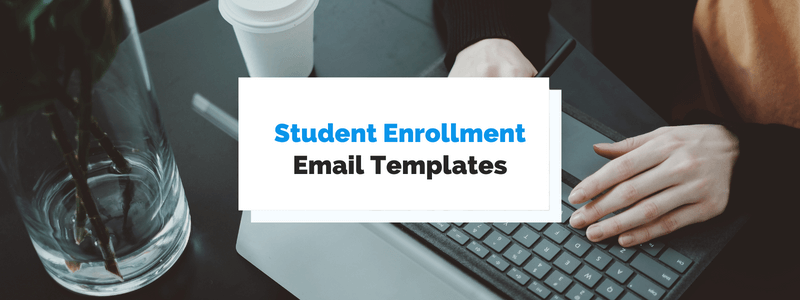For school marketers, email is the most powerful tool for staying in contact with prospects at every stage of the enrollment funnel.
By regularly engaging with prospective students and their parents, you remain front of mind and encourage them along the application and registration process.
But you don’t have time to draft a new email from scratch whenever you contact a student. For more effective marketing and greater student enrollment, you need email templates.
In this article, we’ll show you the best practices for effective school email templates—and then we’ll give you five helpful templates to get you started.
- What Should a School Email Template Have?
- Email Templates for Student Enrollment
- How Email Automation Improves Student Enrollment
- Final Thoughts
What Should a School Email Template Have?
To be successful, a school email template should be as engaging and aesthetically pleasing as possible. Let’s take a look at some features each template should have.
A Great Subject Line
They say never to judge a book by its cover, but everyone does. And it’s the same for emails and subject lines.
A subject line has a profound effect on whether the recipient will open an email.
In fact, one OptinMonster survey found that 47% of email recipients base their decision on whether to open an email on the subject line—and a remarkable 69% use the subject line to determine whether to mark an email as spam.
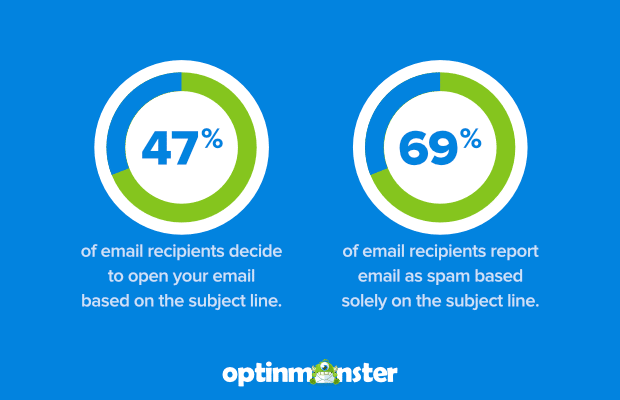
Source: OptinMonster
Arguably the biggest hurdle in your enrollment marketing strategy is just getting your audience to open your emails.
A great subject line sets your emails apart from the rest. It captures the prospective student’s attention and compels them to open the email and read more.
The most successful subject lines follow a few common best practices:
- They’re clear and concise (50 characters or fewer)
- They display a clear name of the sender (instead of “noreply@company.com”)
- They have a friendly and personable tone
- They use action verbs instead of passive ones
- They make the recipient feel special (“You’re invited!”)
- They ask a compelling question (“What college major is right for you?”)
By following these practices, you’re halfway to success.
Placeholders for Personalization
You’re probably sending the same email to dozens—if not hundreds—of prospective students at once. But they shouldn’t feel like a bulk email to your recipients.
You can use personalization tokens to make an email feel personalized without composing a distinct message for each recipient.
Simply include tokens, and your email marketing software can automatically populate these tokens with the right information.
Use the information your school has on hand to personalize enrollment emails wherever possible. For example, your emails might start with a salutation “Hi, {First name}!”
If you use Regpack, it’s easy to personalize emails with merge tags embedded in the body or subject line of an email like this one:
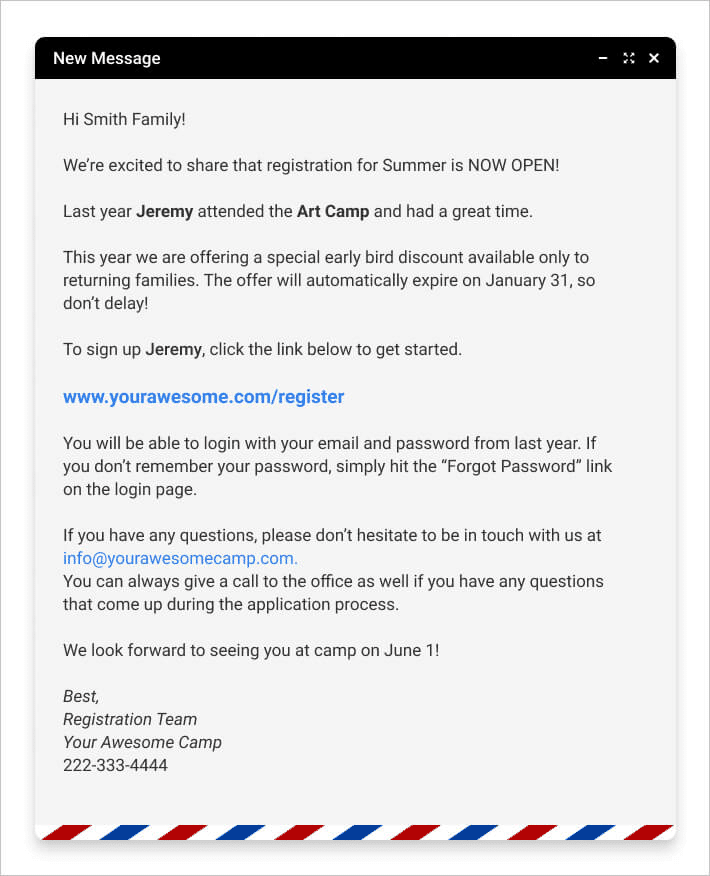
Source: Regpack
If you do use personalized tokens, though, make sure you have a backup plan if your records don’t happen to contain a particular recipient’s information.
You don’t want your email to read “Hi <<First Name>>!” like this one does:

Source: Customer.io
This mishap looks extremely unprofessional and is even more alienating to the reader.
Avoid this issue by using an alternative phrase—like “Hi, prospective student”—whenever the first name isn’t known.
Relevant Images
As they say, a picture is worth a thousand words.
Using visual elements in your enrollment marketing emails keeps readers engaged, so it’s always a good idea to include an image or two in each email.
But don’t just copy and paste a random stock photo and call it a day.
Each photo is a chance to communicate your message more effectively.
Look for a relevant image that not only relates to the theme and topic of your email, but adds context and value to the text.
The most common types of images found in student enrollment emails include:
- In-house—Pictures you took yourself (or even better, that were taken by a professional photographer), e.g., of your campus or a recent student event.
- User-generated content (UGC)—Pictures taken by your students, staff, or alumni. You can encourage your social media followers to post their photos with a branded hashtag, and reposting or sharing those photos in your marketing materials (with their permission) can be powerful social proof.
- Stock photos—When used sparingly, a stock photo from a site like Pexels or Unsplash can add value to your marketing materials.
Whatever photos you choose, make sure they’re the right size for email. We recommend following the advice of email marketing expert Emma Taggart:
Ideally, the height of the pictures used in emails should be kept to less than 200 pixels with a width of up to 600 pixels. However, make sure to test out your emails on various devices to see how they appear before sending them out to customers.
If a photo is too large, it’ll take too long to load—which could result in your readers clicking away, so make sure to follow the best practices.
A Clear Call to Action
Every email you send should have a clear call to action (CTA) that encourages the recipient to take specific steps.
Before composing the email, decide what action you want the reader to take. Should they click a link to sign up for a campus tour?
Should they reply to the email with their questions about the application process?
Then, design your email around your CTA. Every image and line of text should help guide the reader to your desired action.
Finally, tell the reader what you want them to do. An email is no time to be subtle! Invite the reader to take your desired action, then make it easy for them to follow through.
If you want them to visit your website, include a CTA button with a link. If your goal is to get them to fill out an application, the CTA button should take them to the application page.
Regardless of its purpose, the CTA button should be prominent, in bold colors, and surrounded by white space.
Contact Information
Always include your contact information in any email to prospective students.
Listing your phone number and direct email address makes it as easy as possible for them to contact you if they have any questions.
This openness to communication indicates transparency and makes you seem more trustworthy to the recipients.
Mobile-Friendly Design
Most of your prospective students (and their parents) will view your emails on their phones.
In fact, according to HubSpot research, communication viewed on mobile devices makes up the largest percentage of email opens at 41%.
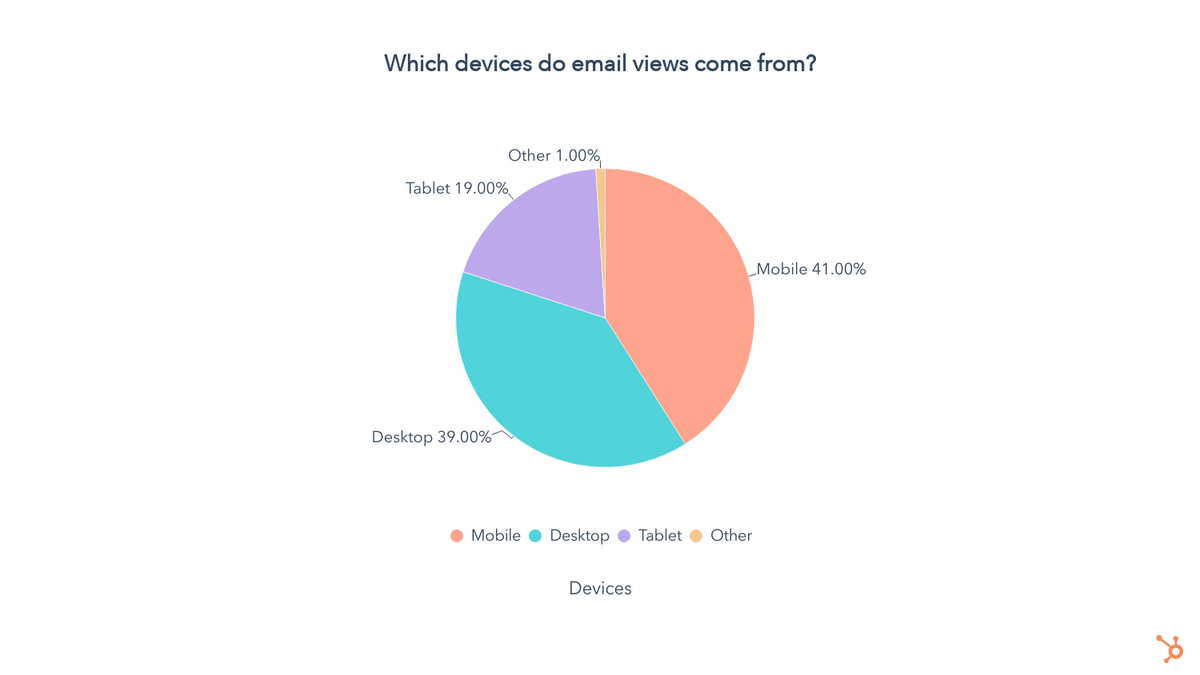
Source: HubSpot
Desktop (39%) is relatively close behind, but if we count tablets (19%) as mobile devices on a par with phones, this prevalence is even more prominent.
In any case, ideally, each email should be responsive and look great no matter what device your readers are using.
Each email should have a mobile-friendly design.
Follow these tips to ensure your emails can be read easily (and look great) on any device:
- Use a one-column layout—Multiple columns look great on a desktop, but they can be confusing and not always translate well on mobile.
- Include larger fonts—Big fonts are easier to read on smaller screens.
- Use buttons instead of hyperlinks—It can be tricky to click on a line of text on a small screen. Instead, rely on buttons for any CTAs in your emails.
- Include images, but don’t make them your focus—Many mobile email apps don’t load images as the default setting, so make sure your email looks good (and conveys all necessary information) without images.
- Ensure dark mode compatibility—Since dark mode is increasingly popular for an easier reading experience that saves battery life, it’s a good idea to make sure your email and images look good against a black background.
If you follow these practices, you will make your email convenient and pleasing to the reader.
Email Templates for Student Enrollment
Impactful student enrollment management requires constant communication.
You should be emailing prospective students at important points along their journey, beginning early in the application process.
In this section, we’ll provide five email templates to get you started.
Reach Out to High School Seniors
Most of your leads will fill out inquiry forms through your school’s website.
From there, it’s the email marketer’s job to reach out to prospective students, convince them why they should enroll, and put them on the path to enrollment.
This email from Arizona State University is a great example of reaching out to high school seniors during their summer break:

Source: Really Good Emails
The color scheme is bright and cheerful, and the email body takes advantage of the reader’s excitement for summer while also putting the next year into perspective.
Using this example as inspiration, here’s a template to get started:
Subject line: Summer’s officially here!
Hi [Student Name],
In a few short months, you’ll start one of the most memorable times of your life: senior year. Now is a great time to start planning for college and learning more about [School Name].
Here are a few things you can do to prepare this summer:
- Attend a summer camp. Did you know [School Name] offers summer camps for high school students? Click here to learn more about this year’s session, which runs from [Date] to [Date].
- Schedule a campus visit. Explore our campus, meet our faculty, and get answers to all of your burning questions about financial aid, housing, majors, and more. Click here to choose a day that works for you!
- Start your application. Our application period opens on [Date], so it’s a good idea to review our application requirements here and ensure you’re on the right track.
And of course, don’t forget to take some time for fun, relaxation, and self-care! Take that trip to the pool, and go on that outdoor adventure. We’ll see you soon at [School Name]!
[Your Name]
[Title]
[School Name]
[Phone Number]
[Email Address]
Summer break is a great time for high school seniors to consider their college applications and plan a campus visit.
Urge Students to Fill Out Your Application
Another important email template in your arsenal is the application reminder.
Your prospective students may feel overwhelmed by applications and deadlines, so anything you can do to support them and provide helpful resources makes it more likely that they’ll follow through.
This email from the University of San Diego Kroc School is a great example:

Source: Direct Development
Instead of nagging about an approaching deadline, this email focuses on providing helpful assistance to prospective students.
The CTA buttons invite students to register for an upcoming Office Hours session, start or resume their applications, or schedule a meeting with admissions.
Here’s an email template you can use:
Subject line: [School Name] is on your team.
Hello [Student Name]!
I’m [Your Name], your enrollment advisor, and I’m thrilled you’ve shown interest in applying to [School Name].
With application deadlines rapidly approaching, it’s understandable to be overwhelmed—or just need a little encouragement to get across that finish line. I’d love to invite you to join our Enrollment Party on [Date] from [Start Time] to [End Time].
At the Enrollment Party, you’ll sit down with one of our staff members and have any lingering questions about the application process answered. This is a special opportunity to get expert help submitting the best application possible. We’ll also waive your application fee as a thank-you for stopping by!
Join us on [Date] anytime from [Start Time] to [End Time] and leave when you’re ready. Click the button below to reserve your spot!
[CTA Button]
Can’t make our Enrollment Party? I’m still available to answer any questions you may have. Feel free to reply to this email or call me at [Phone Number] anytime! I’m available to help you explore your options and learn more about applying to [School Name].
Best wishes,
[Your Name]
[Title]
[School Name]
[Phone Number]
[Email Address]
As you can see, the tone of the email is inviting and encouraging.
Encourage Students to Explore Your Courses
One way to attract more applicants is to show off the unique benefits of your academics.
By encouraging prospective students to explore your courses and programs, you’ll highlight what makes your school special—and help motivate them to apply.
This email from the University of Maryland is a great example:
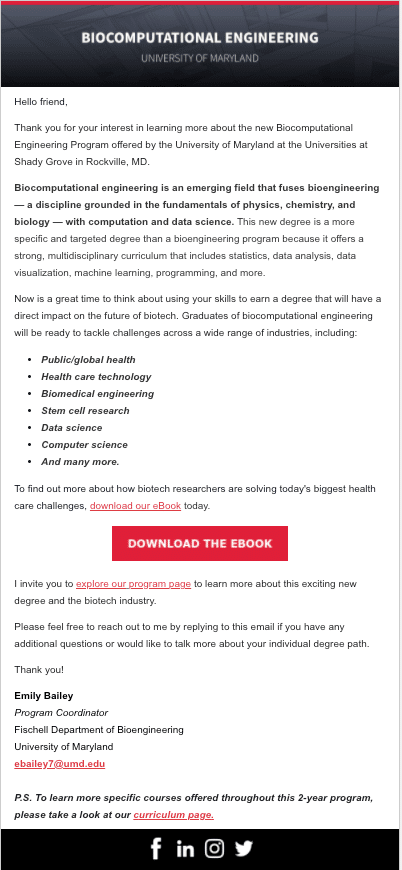
Source: Direct Development
This email was sent to prospective students who showed interest in a specific program.
The email body is full of helpful information on that program, with a link to the program page and a CTA button inviting the student to download an in-depth ebook.
Here’s a template to get you started, but you should fill in details about your specific courses or programs and what makes them special:
Subject line: Explore our courses at [School Name]
Hi [Student Name],
We’re happy to hear you’ve expressed interest in [Program]! Whether you’ve settled on [Program] as your major or you’re still exploring, we thought you might like a little more information.
[insert detailed information on the program, including potential careers and how the field is growing.]
To learn more about the courses we offer in the [Program], check out this in-depth brochure:
[CTA button with a link to brochure/ebook or website landing page]
Please reach out to me if I can answer any questions about our curriculum and programs at [School Name]!
[Your Name]
[Title]
[School Name]
[Phone Number]
[Email Address]
Students are often overwhelmed during the enrollment process, so making it easy for them to access the information they need might help sway their decision in your direction.
Recommend Your Online Courses to Students
Whether you’re an online course creator or a traditional university offering online programs, you need an effective marketing email to highlight new online courses.
This email from Codecademy is a great example:
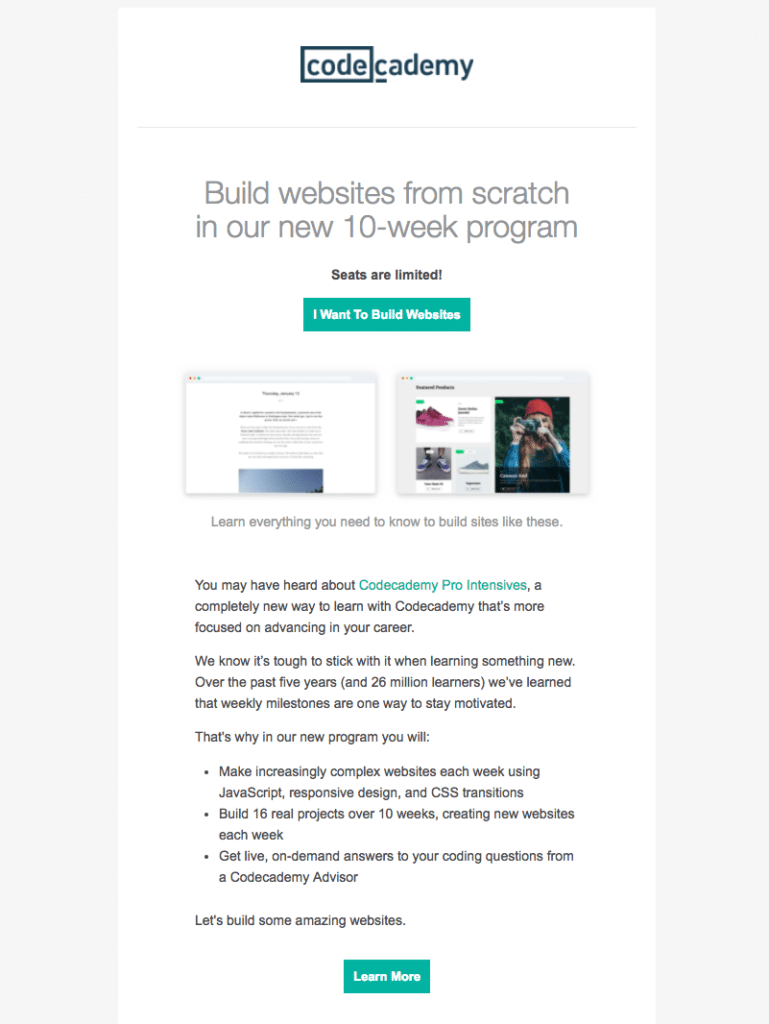
Source: Email Design
The email is simple and effective, creating a sense of urgency (“seats are limited”) and listing the tangible benefits of attending the course.
You can use the template below in your enrollment marketing efforts:
Subject line: Start learning from home with [School Name]
Hi [Student Name],
We’d like to invite you to enroll in our upcoming online course: [Online Course Name]!
[Include information on the benefits of the course]
In this [number]-week course, you’ll learn:
- [Topic 1]
- [Topic 2]
- [Topic 3]
Our students from around the world have completed over [Number] hours of coursework from the comfort of their own homes, setting them on the path to successful careers. Join us online today!
[CTA Button]
Warm regards,
[Your Name]
[Title]
[School Name]
[Phone Number]
[Email Address]
The template above lists the benefits of the online course and encourages the student to sign up with a conveniently placed CTA button.
Invite Students for a Tour of Your School
Finally, it’s important to encourage prospective students to attend open houses or schedule a campus tour to get a feel for your institution.
Your email template should mention the benefits students will gain during their visit, like meeting faculty members, interacting with other students, and determining if the campus is a good fit.
Get started with this template:
Subject line: [Student Name], you’re invited!
Hello [Student Name],
Have you visited our campus at [School Name] yet? If not, let me personally invite you to our open house on [Date] from [Start Time] to [End Time].
During the open house, you’ll get to meet many of our esteemed professors, learn your way around the campus, and discover the unique amenities our school offers.
Spots are limited, so register now to reserve a spot!
[CTA Button]
If you can’t make our open house date—that’s okay! You can visit [this link] to schedule an individual campus tour on a day that works for you and your family.
Hope to see you soon,
[Your Name]
[Title]
[School Name]
[Phone Number]
[Email Address]
As you can see, the email sets expectations for the event and fosters a sense of urgency, while also providing alternatives for those who can’t attend.
How Email Automation Improves Student Enrollment
While it’s definitely helpful to have templates for all the emails you send regularly, email automation can save you even more time.
When it comes to enrollment management, automated email marketing tools like Regpack are faster and more efficient than editing a template for each new email.
Regpack’s trigger-based communication tools send an email automatically whenever a prospective student or parent takes a predefined action.
For example, if a prospective student fills out a contact form, that can trigger a new welcome email that starts them on the enrollment funnel automatically.
You can also set up automated email reminders to ensure each prospective student is informed about upcoming registration deadlines and session dates.
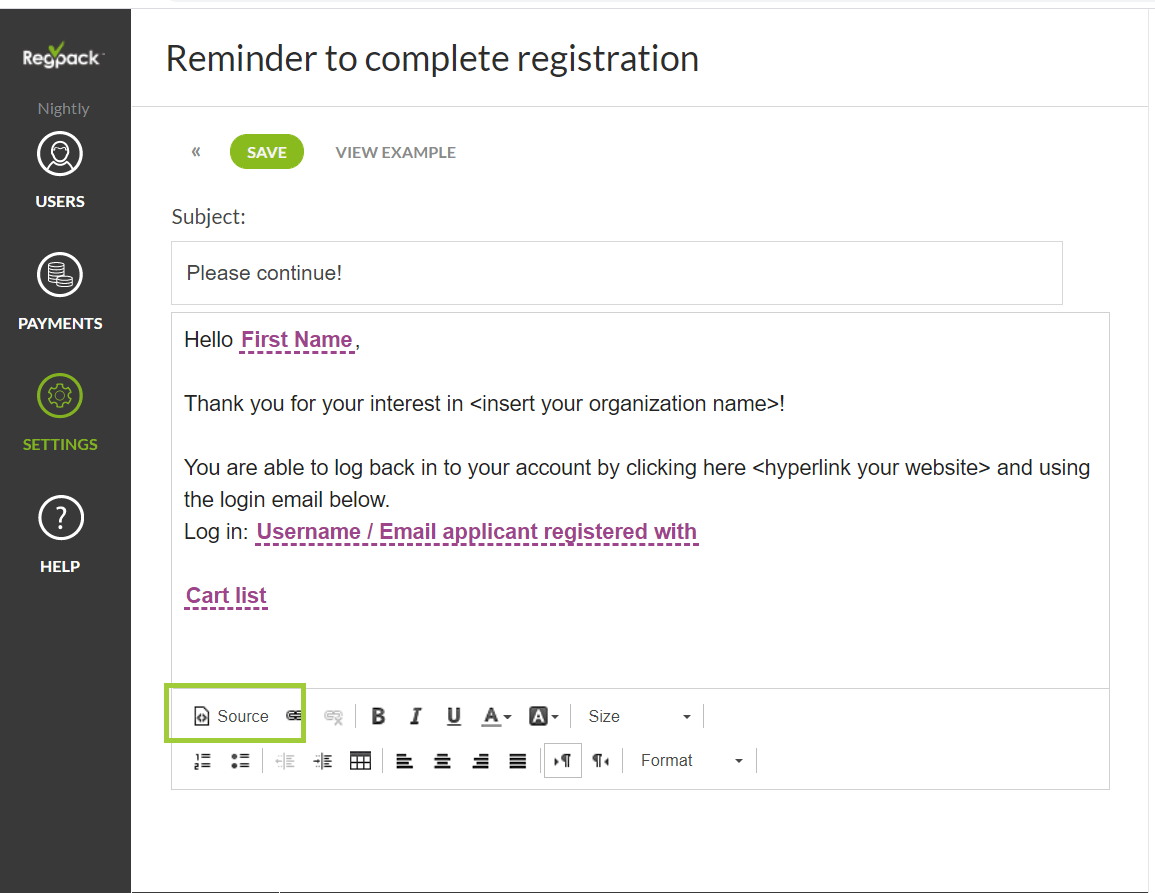
Source: Regpack
In the platform, you can set up email templates that are a combination of text and blank fields—like {First Name}, {Age}, or {Location}, which auto-populate upon sending.
Final Thoughts
Today’s students are inundated with options for their higher education. You need to be front of mind if you want to stand out from the competition and increase student enrollment.
What better way to engage with prospects than through their email, which they check daily?
Use the email templates above to build a consistent email marketing funnel for your enrollment efforts.
And if you want to save even more time and effort, consider using email automation tools like Regpack to ensure no prospect goes unnoticed.


